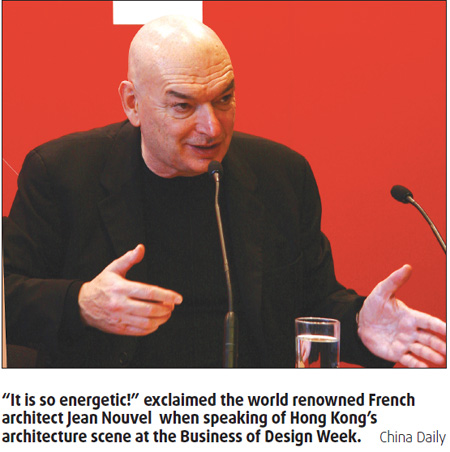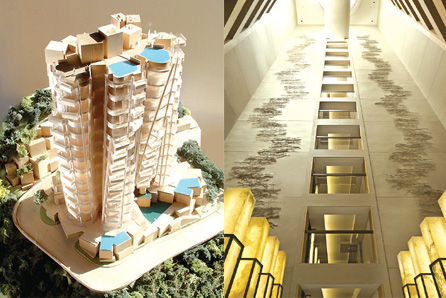Property boom, architects' dream
Updated: 2009-12-18 07:29
By Ying Yuhua(HK Edition)
|
|||||||
|
(Left): Luxury residence at 53 Stubbs Road by Frank Gehry. (Right): Swire Hotel's Upper House by Andre Fu. China Daily |
HONG KONG: When Jean Nouvel, the French architect who won the industry's highest honor the 2008 Pritzker Prize, was asked about the limitation of Hong Kong architecture, a puzzled look flashed across his face.
"I have been asked this question all the time since I arrived. I don't understand why Hong Kong people think this place is boring," said Nouvel after a presentation during Business of Design Week (Bodw) 2009 earlier this month. "I think Hong Kong is already a world-class city. Look at your airport! Look outside the window!" he gushed.
Nouvel, who created the legendary Agbar Tower in Barcelona, put down a glass of water and pointed at the skyline outside Hong Kong Convention and Exhibition Centre, dotted with cranes along the Wan Chai reclamation area.
"It is so energetic!" He remarked, effusively, adding, "You already have Norman Forster, I.M Pei, Frank Gehry. You have so many masterpieces to be proud of!"
It seems many other guest speakers shared the same feeling in this year's Bodw - an annual festival at which internationally renowned design professionals and businessman network and schmooze - where epithets like "energetic", "promising", "optimistic" lubricate conversations describing the city's look.
Architects are always the first to feel the "optimism" of the property market, so it is no surprise that many legendary architects are tapping into Hong Kong at a time when the real estate industry is heating up. The transactions of first-hand luxury properties recorded a 14-year high in the first 11 months of this year, according to data from Centaline Property Agency.
Barrie Ho, a famous architect who is the Founder of Barrie Ho Architecture Interiors, once said that the city's art of architecture was limited by its nature conditions.
He believes that because of Hong Kong's large population and geographical limitations, urban buildings are inevitably high-density skyscrapers, and that the developers' preference for this form will stifle architectural creativity.
However, as competition intensifies, developers and buyers alike are increasingly aware that adding design elements is a major trend and a way to add to the value of the property, allowing developers to sell flats at a premium price.
For instance, Swire Properties has brought Frank Gehry, the designer of the Guggenheim Museum in Bilbao, to the city. Gehry has designed a blooming-petal-shaped luxury residence at 53 Stubbs Road - overlooking Victoria Harbour, which is expected to be completed in 2011.
The company hasn't disclosed the exact cost for designing the house, but people familiar with the case estimated the fee would be no less than $2.8 million.
However, Swire believes every dollar has been well spent. "In terms of rent, this project could be the next 'most expensive apartment' in Hong Kong," Swire Properties Chief Executive Martin Cubbon told China Daily.
"Today's consumers are becoming more sophisticated, and they are aware of what benefits a thoughtfully planned and well-designed building can bring," Mr. Cubbon said. "To achieve the quality we are committed to, certain levels of investment in terms of time and other resources are necessary."
Local designers are also contributing to this exciting trend. The recently launched Upper House, the first property of Swire Hotels, was left in the hands of Hong Kong's Cambridge educated interior designer Andre Fu.
This hotel, which took Fu four years to create, was likened by him to his own house - since the developer gave him a lot of freedom to let his taste dictate the design. He participated in almost every aspect of the creative process, ranging from the selection of background music to the choice of graphics on the wall, giving the hotel and its neighborhood a very special sense of space.
As the property market gathered momentum and design became a key element, the number of people working for architectural and related consulting companies surged by 30 percent last year.
Ironically, bumps in the overseas markets could have a negative impact on Hong Kong's architectural scene. Eighty percent of projects in Dubai have been suspended due to its debt crisis, which will affect five or six big Hong Kong architectural firms in Dubai, resulting in large-scale lay-offs.
More than 200 architects are on their way back to Hong Kong, and many are worrying about the looming competition for jobs.
"It is the second wave of retreat since the financial crisis, but we think they could be absorbed by the market," said Anna Kwong, President of Hong Kong Institution of Architecture, who believes there are lots of opportunities brought by the mainland and Macao, where quite a number of projects have been "taken out of the refrigerator".
"There will be a steady growth in the next two years," Ms Kwong said, adding, "Because of the government's support and the city's close tie with the mainland and Macao, architects can find more opportunities here."
As for the prospects for growth for young architects, Ms Kwong said most Western architectural masters working in Hong Kong would like to team up with local firms in order to understand the city's cultural context and construction policies, which means local architects could participate in the design process. "This is the best education for our young architects," Ms Kwong said.

(HK Edition 12/18/2009 page3)
